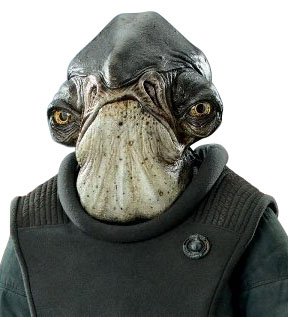Alliance Fleet
| Rank | Title |
| 0 | Trainee |
| 1 | Deckman |
| 2 | Senior Deckman |
| 3-4 | Petty Officer |
| 5-6 | Chief Petty Officer |
| 7-8 | Ensign |
| 9 | Lieutenant |
| 10 | Commander |
| 11 | Captain |
| 12+ | Admiral |
The Alliance Fleet is the Rebels' most important military force. The fleet gives the Rebels the mobility and firepower it needs to legitimately challenge Imperial military forces. However, as the fleet is only a small fraction of the size of the Imperial Navy, it must pick and choose its battles very carefully. Mon Mothma has forbidden Admiral Raddus from engaging the Imperials directly in a large-scale battle (much to the curmudgeonly old Mon Calamari's irritation). By and large the Alliance lacks the means to replace capital ships or large swathes of vessels at once, so it cannot afford to undertake any action that endangers a large part of the fleet at any one time. "The Alliance can survive the loss of its central command base or its fleet, but not both," Mon Mothma is famously quoted as saying, and the Alliance's command structure agree with her.
Organization
Ranking in the naval structure is fairly straightforward.
- Trainee: Rank 0. Trainees often serve in apprenticeship roles alongside petty officers, but more and more the Alliance Fleet is arranging dedicated training programs where trainees can quickly be taught what they need to know.
- Deckman: Rank 1. Deckmen are the rank and file aboard navy vessels.
- Senior Deckman: Rank 2. Senior deckmen are effectively the same rank as deckmen, but are looked to by their superiors to lead as examples to their fellows, while their superiors watch for those with the making of leaders.
- Petty Officer: Rank 3-4. The earliest command position, petty officers may operate as captain of a small vessel of about patrol boat or transport size, but more likely serve as mid-level command aboard a larger vessel.
- Chief Petty Officer: Rank 5-6. Chief petty officers may hold command of naval freighters, or may oversee a section of petty officers and their crews aboard a larger vessel.
- Ensign: Rank 7-8. An ensign may be given command of a corvette or frigate, or serve as bridge crew aboard a larger vessel.
- Lieutenant: Rank 9. Like an ensign, a lieutenant is likely to be given command of a corvette or frigate, or to serve as bridge crew aboard a larger vessel.
- Commander: Rank 10. A commander is the lowest rank that is given command of one of the Alliance's few capital ships. They are also likely to be given command of a fleet section (see Structure, below).
- Captain: Rank 11. Captains are usually the commanding officers aboard Alliance capital ships, and may be given command of a squadron.
- Admiral: Rank 12+. Admirals are given command of capital ships, and usually the squadron attached to that capital ship. Admirals senior enough to be entrusted with a battle group are referred to as "line admiral."
Structure
The Fleet's structure is not permanently organized into specific ship models or designs, unlike the Imperial fleet. Elements of the fleet are combined on an ad hoc basis, building specialized groups to tend to specific Rebel missions, and then reabsorbed into the greater fleet afterwards. This makes the fleet available across the galactic disk, whether tending to specific missions for High Command, or allocated to other Alliance forces (notably Sector Commands). Some of the organized groupings include:
- Element: 1 vessel. A single starship is known as an element, commanded by the vessel's captain.
- Section: 3-12 vessels. A cluster of up to a dozen starships. Heavy cruisers are rarely available for such a small command (though specialized missions might warrant one or two of them). More often, a section is made up of 3-8 corvettes, frigates, or similar light capital ships. If the section is made up of both capital vessels and close-support ships, it is called a flotilla. The most senior vessel's captain acts as the commander.
- Squadron: 12-36 vessels, plus support units. Four sections are combined into a squadron, using such elements as a line of capital ships, a section of escort ships, or a picket line of armored freighters. The squadron is the most common fleet detachment assigned to general Alliance missions – any task that requires more than a squadron to accomplish is usually under the command of Fleet Command itself. Squadrons are commanded by a senior captain or admiral, as directed by Fleet Command or Alliance High Command. Sector Commands with squadron-level resources usually rank its commander as a commodore.
- Battle Group: 48-72 vessels, plus support units. Two to four squadrons may be combined into a battle group under the command of a line admiral.
